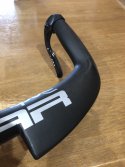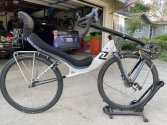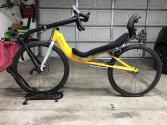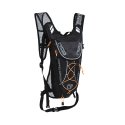One thing I like about Cruzbikes is how many down-the-rabbit-hole questions there are. Handlebar choice is one of them. There are seemingly dozens of possibilities, and riders find their way to what works best for them over time, some trial and error, and asking around, just as you're doing here.
I use the Genetic Digest (no, I don't understand the name either) flared drop bar, 44cm width. It's similar to the current CB stock bar and Salsa's Cowchipper bar, though a little narrower, which I prefer. I have three hand positions. The main one I use is on the flat part of the "drop," just beneath the shifter body. That's where I have the greatest sense of power and control. When I'm feeling chill and the road is open, I'll grab the hoods. Even though they weren't designed for this orientation, to me they offer a natural feeling grip, with access to brakes and shifting. finally, when I'm rolling miles and miles of tempo, my hands might slide down toward the end of the drops and hang out there. One thing I like about these bars over the others is that slight bend toward the bar end. My wrists settle nicely into that little crook.
These bars, for me, are aero enough--my hands aren't too wide apart, hanging out in the wind--but also wide enough to give me good arm leverage for hard efforts, climbing, and fast maneuvers. Your upper body will get a workout, and bar choice will affect how your upper body can and will interact with the bike, for better or worse. I think that for many people new to the CB design, the current V20/S40 stock bar is a great place to start, especially with the learning curve still ahead. And I would imagine that many riders end up sticking with that bar.
In the end, it may come down to what kind of riding you tend to do.
@Frito Bandito 's bar setup is super sexy. It looks fast even at a standstill. He is also a master at seeking every aero advantage as he crushes it on longer, fairly flat routes. He has said in the past that climbing is not one of his favorite things to do on a bike. I, on the other hand, love to climb, and am fairly aero-illiterate (I don't even know what CdA stands for). I look at his bars and think, "I wouldn't want to climb with those because I don't think I would have the leverage I would want/need to torque my way up steeper grades." But put my bars on Frito's bike, and he would most likely hate what they would do to his aero metrics on his flatter, faster routes. Though our bars are different, we each have what is right for us.
Finally, after 27 years and roughly 200,000km on DF road bikes, my lower back forced me to consider alternatives. Seven years ago I took a gamble and bought that yellow V20 pictured below (now replaced by a yellow V20c). It has been the best bike purchase I ever made. Just a nudge, if you're still undecided.






